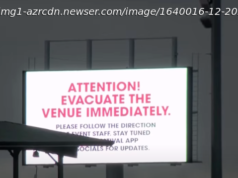 Denis Poroy / AP
Denis Poroy / AP
San Diego Chargers wide receiver Dontrelle Inman, right, is tackled by Miami Dolphins free safety Michael Thomas during the first half in an NFL football game Sunday, Dec. 20, 2015, in San Diego.
By Ken Belson, New York Times News Service
Thursday, Jan. 12, 2017 | 2 a.m.
The Chargers appear set to return to Los Angeles for next season after more than a half-century in San Diego and several failed attempts to build a new stadium.
The Chargers, who began play in Los Angeles in 1960 as part of the old American Football League, are expected to share a $2.6 billion stadium being built by the Rams in Inglewood, about 10 miles from downtown.
The move would give the Los Angeles region — the country’s second-largest market — two NFL teams for the first time since 1994, when the Rams and the Raiders played there, and would leave the league without a team in San Diego, a stalwart market that has hosted three Super Bowls.
Team owner Dean Spanos was expected to make the decision official Thursday, when he was to speak to the Chargers’ staff, according to a person with knowledge of the matter who spoke on the condition of anonymity because the announcement had not yet been made.
Adam Schefter of ESPN first reported that the Chargers would leave San Diego.
The league’s stadium and finance committees met in New York on Wednesday but offered no new financial incentives to help the Chargers in their efforts to build a new stadium in San Diego. The Chargers did receive an extension of two days, to next Tuesday, on the deadline for them to decide whether to move in with the Rams.
After the meeting, according to the person with knowledge of the matter, Spanos notified Commissioner Roger Goodell and several team owners that he would be moving the Chargers to Los Angeles, something that had appeared all but inevitable since November, when voters in San Diego shot down a proposal to use hotel taxes to help the team build a new stadium.
An NFL spokesman declined to comment. A Chargers spokesman did not immediately respond to a request for comment.
The Chargers for years were unable to forge a deal with a succession of mayors to build a jointly financed replacement for Qualcomm Stadium, one of the oldest stadiums in the league. The city also lacked the concentration of big corporations that the league and teams often consider critical to supporting a team.
The Chargers’ decision to leave comes almost exactly a year after the team owners decided to allow the Rams to leave St. Louis and return to Los Angeles. The Chargers, who had teamed up with the Oakland Raiders to make a separate bid to move to the Los Angeles area, were rebuffed. But the Chargers were given one year to decide whether they wanted to move in with the Rams in Inglewood.
Early last year, Spanos unveiled a plan to build a new stadium in downtown San Diego. But the plan assumed hundreds of millions of dollars from an increase in the local hotel bed tax, a contribution that voters resoundingly rejected in November, leaving the team and the city with no working alternative.
Spanos, whose father, Alex, bought a majority share of the Chargers in 1984, repeatedly said he wanted to find a way for the team to stay in San Diego.
Ultimately, though, the business rationale for moving made far more sense than trying to find a solution in San Diego. Even if a proposal for a new stadium in San Diego were to emerge, the public would have to approve any stadium-related tax hikes, something it already rejected.
In Los Angeles, the Chargers would be a tenant in the Rams’ stadium, so Spanos would not have to spend years and potentially billions of dollars buying land and overseeing construction. The Chargers would have to pay a relocation fee, which would come to $650 million if it is paid over 10 years. But to soften the blow, the NFL owners have allowed the Chargers to exceed the league’s debt limit and borrow as much as $325 million — half of the relocation fee. The Chargers could also raise money by selling personal seat licenses and sponsorships.
The Chargers would have to find a temporary home in Los Angeles until 2019, when the Rams expect to open their stadium. The Chargers could share the Los Angeles Coliseum with the University of Southern California and the Rams or play at StubHub Center, a 30,000-seat soccer stadium in Carson, California. They would also need a temporary practice complex and team offices, most likely in Orange County.
The move would not be without its risks. Spanos said a quarter of the team’s fans were in Orange County and Los Angeles, but it is unclear how many fans in San Diego would be willing to make the 120-mile drive to see the team play in Los Angeles, where tickets would undoubtedly be more expensive.
The Chargers would also have to compete for fans and sponsors with the Rams, who have had a one-year head start in Los Angeles, where many football fans root for out-of-town teams like the Cowboys, the Packers and the Raiders.






